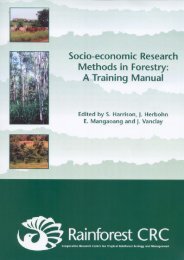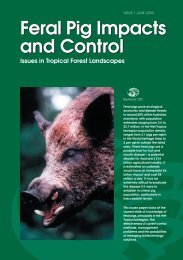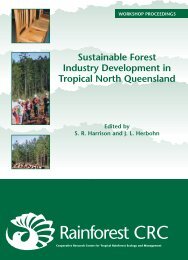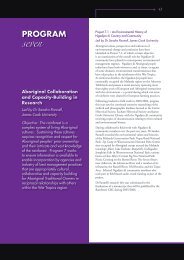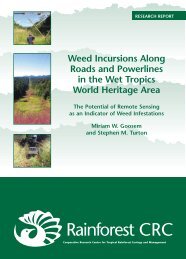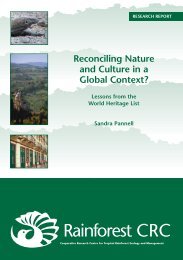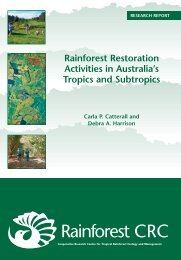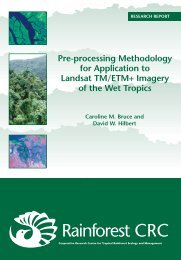Reconciling Nature and Culture in a Global Context? - Rainforest ...
Reconciling Nature and Culture in a Global Context? - Rainforest ...
Reconciling Nature and Culture in a Global Context? - Rainforest ...
Create successful ePaper yourself
Turn your PDF publications into a flip-book with our unique Google optimized e-Paper software.
<strong>Reconcil<strong>in</strong>g</strong> <strong>Nature</strong> <strong>and</strong> <strong>Culture</strong> <strong>in</strong> a <strong>Global</strong> <strong>Context</strong>?Lessons from the World Heritage ListCHAPTER FOUR – THE CONVENTION AND WORLDHISTORYHeritage is our legacy from the past, what we live with today, <strong>and</strong> what wepass on to future generations – UNESCO World Heritage CentreOne of the commonly heard criticisms of World Heritage list<strong>in</strong>g is that it sanitises the past<strong>and</strong> museumifies social practices. Moreover, <strong>in</strong> attempt<strong>in</strong>g to protect heritage fromperceived damag<strong>in</strong>g or threaten<strong>in</strong>g external forces, list<strong>in</strong>g often overlooks or negates the factthat many heritage sites are the products of “local responses to <strong>and</strong> engagements withregional, national <strong>and</strong> global political, cultural <strong>and</strong> economic dynamics” (Adams 2005: 153).In the past five years or so, there has been a dramatic <strong>in</strong>crease <strong>in</strong> the number of WorldHeritage sites listed which specifically allude to <strong>and</strong> identify the ‘fusion’, ‘<strong>in</strong>terchange’,‘<strong>in</strong>teraction’ or ‘<strong>in</strong>tegration’ of different values <strong>and</strong> cultures as justification for <strong>in</strong>scription.Some of these ‘encounters’ are further l<strong>in</strong>ked to ‘<strong>in</strong>ternational trade’ (e.g. the Historic Centreof Macau listed <strong>in</strong> 2005) or are described as part of an early phase of ‘globalisation’ (e.g. theHistoric Quarter of the Seaport City of Valparaiso listed <strong>in</strong> 2003). While some of the‘heritage’ produced from these encounters – e.g. railways, villages, towns, cities – isidentified as ‘colonial’, rarely if at all, are the <strong>in</strong>teractions between Europeans (ma<strong>in</strong>ly theBritish, Portuguese, <strong>and</strong> the Spanish) <strong>and</strong> locals characterised as such. Prior to 2000, itappears that former European colonies <strong>in</strong> South America, Africa, <strong>and</strong> Asia largely, thoughnot exclusively, nom<strong>in</strong>ated ‘natural’ properties, such as the Virunga National Park <strong>in</strong> theDemocratic Republic of the Congo (listed <strong>in</strong> 1979), pre-historic ‘cultural’ sites, such as theJoya de Ceren Archaeological Site <strong>in</strong> El Salvador (listed <strong>in</strong> 1993), or pre-colonialmonuments, such as the Taj Mahal <strong>in</strong> India (listed <strong>in</strong> 1983). As the example of the Taj Mahalillustrates, however, the advent of European colonialism <strong>in</strong> its various temporal <strong>and</strong> spatialmanifestations around the world did not signal the onset of a history of cultural <strong>in</strong>terchanges.World Heritage sites, such as the Taj Mahal, the Borobudur Temple Compounds <strong>in</strong> Indonesia<strong>and</strong> the Khami Ru<strong>in</strong>s National Monument <strong>in</strong> Zimbabwe, po<strong>in</strong>t to a long history of cultural<strong>in</strong>teractions <strong>and</strong> exchanges between the local <strong>and</strong> the global. Indeed, while sometimes notofficially recognised <strong>in</strong> the list<strong>in</strong>g process, many World Heritage properties are truly globalsites as a consequence of their placement with<strong>in</strong> colonial <strong>and</strong> pre-colonial histories. AsMaddern argues with respect to Statue of Liberty-Ellis Isl<strong>and</strong> National Monument, these sitesare not just illustrative of important chapters <strong>in</strong> national histories, but they also represent a“def<strong>in</strong><strong>in</strong>g moment <strong>in</strong> world history” (2005: 25).In this section of the report, I exam<strong>in</strong>e to what extent the World Heritage List has developedbeyond a representation of colonialism as a celebration of past glories or qua<strong>in</strong>t oldbuild<strong>in</strong>gs. With particular reference to the World Heritage site of the Military Fortress ofSuomenl<strong>in</strong>na (listed <strong>in</strong> 1991) <strong>and</strong> one of the most recently listed properties, the HistoricCentre of Macau (listed <strong>in</strong> 2005) 50 , I report on two very different depictions of the ‘colonialexperience’. Focus<strong>in</strong>g specifically on ‘colonial’ World Heritage sites raises some <strong>in</strong>terest<strong>in</strong>gquestions as to whose values <strong>and</strong> whose heritage is preserved <strong>and</strong> promoted at thesetransnational, multicultural locations. And, perhaps more importantly, particularly given thehistory of colonialism, it also queries who <strong>and</strong> which historical events are forgotten <strong>in</strong> thisprocess.50 As part of a comparative research project exam<strong>in</strong><strong>in</strong>g several World Heritage sites, I visited both ofthese properties <strong>in</strong> October <strong>and</strong> November 2005.47




